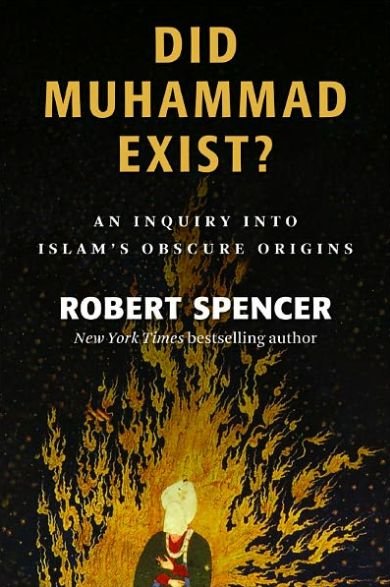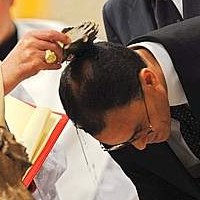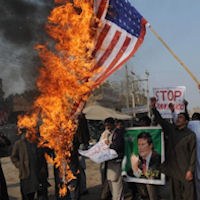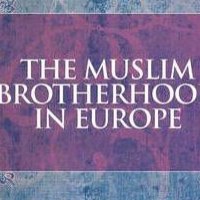![]()
Fri, May 25, 2012 | Middle East Forum | Reviewed by Aymenn Jawad Al-Tamimi
Did Muhammad Exist?
An Inquiry into Islam’s Obscure Origins
by Robert Spencer
ISI Books, 2012. 254 pp. $27.95
First published in The American Spectator.
Go to a high-street or online bookstore, and one can find numerous biographies written about Muhammad — the reputed founder of Islam — by the likes of Karen Armstrong and Tariq Ramadan. These works — generally apologetic in nature — wholly rely on the traditional Islamic accounts of the Prophet’s life, and if they ever delve into the question of the reliability of those sources, it is only in the hope of explaining away incidents in Muhammad’s life that might come across as unsavory to modern readers.
Such an approach, however, simply will not do for genuine historical research. One cannot adopt a pick-and-mix method to determining what aspects of Muhammad’s life actually occurred on moralistic grounds. It is in this respect that Robert Spencer’s latest book differs from the writings of Armstrong and Ramadan.
Without indulging in polemics or pushing a partisan political agenda, the author simply investigates the question of whether we can really trust the traditional Islamic accounts for the life of Muhammad and the supposed early days of Islam during the Arab conquests.
To be sure, serious scholarship on Islamic historiography dates back to the latter half of the 19th century — with the works of the Belgian Jesuit Henri Lammens and the acclaimed Geschichte des Qorans by Theodor Noldeke, to name just two pioneers of the field — and Spencer makes no pretense to originality.
Yet a traditional problem with Islamic historiography has been the intended audience: that is, the academic specialist assumed to have extensive background knowledge, rather than the general reader. Thus, Spencer’s book serves a useful purpose, for it flows nicely while providing the reader with a firm grounding for delving deeper into the subject. Indeed, the author provides a handy “Further Reading List” (pp. 239-40) for anyone interested in consulting specialist works. Spencer also deserves credit for integrating his sources nicely into his writing, avoiding the practice of simply quoting verbatim large chunks from other authors.
So what are the main arguments against the historicity of the traditional Islamic accounts of Muhammad’s life and the subsequent rise of Islam through the Arab conquests?
To begin with, contemporary non-Muslim sources of the 7th century do not corroborate the canonical story. For example, the Doctrina Jacobi (a document dating to 634-40 CE and probably written by a Christian living in Palestine; p. 20), an account of the Arab conquest of Jerusalem by Sophronius — the patriarch who is said to have surrendered the city in 637 — and a letter written in 647 by the patriarch of Seleucia make no reference to the Arab conquerors as Muslims, or show any awareness of a religion called Islam.
The earliest account that can reliably be taken to refer to Muhammad is a chronicle by the Armenian bishop Sebeos, dating either to the 660s or 670s but containing material that sharply diverges from the traditional Islamic accounts: thus he has Muhammad “insisting on the Jews’ right to the Holy Land — even if in the context of claiming that land for the Ishmaelites, acting in conjunction with the Jews” (p. 32).
Only by around 730 CE, nearly one hundred years after Muhammad’s death in 632 CE according to the canonical story, do we see an account by John of Damascus make detailed reference to parts of the Qur’an, but even then he does not name the Qur’an or allude to the existence of a complete holy book for those he calls “Hagarians,” “Ishmaelites” or “Saracens” (but not Muslims).
Instead, we have reference to Qur’anic chapter titles like “The Women” (this is the fourth Sura of the Qur’an today), implying that he was drawing on fragments of text that were later incorporated into the Qur’an.
Arabic epigraphic evidence from the 7th century similarly fails to validate the canonical account. An inscription attributed to the first Umayyad caliph — Muawiya — in 677 or 678 CE makes reference to belief in God but gives no indication of belief in Muhammad as his messenger or the Qur’an as revealed scripture.
On coins from this period, we do find the word “Muhammad” inscribed, but curiously the inscription comes under kingly figures bearing a cross, a symbol of Christianity that is totally antithetical to traditional Islam (pp. 43-4).
Bearing in mind that “Muhammad” can also mean “the chosen/praised one,” the coins could well be conveying the idea that the ruler is praised or chosen in God’s name (p. 45). Alternatively, they could be referring to Jesus — at a time when the religion of the Arab conquerors was still a vague monotheism — or a proto-Muhammad figure still very much unlike the man depicted in the traditional accounts of his life. Even the inscriptions on the Dome of the Rock — completed in 691 CE and often thought to be the first elaborations on traditional Islamic theology — could be referring to Jesus, explaining how he (“Muhammad”) is a mere messenger and not divine as orthodox Christianity held (pp. 56-7).
It is only towards the middle of the 8th century (735 CE onwards) that we begin to see very clear epigraphic evidence referring to Muhammad as we know him from the Ahadith (plural of hadith) and Sira (pp. 61-2). This observation leads nicely to an examination of the reliability of biographical material from the Ahadith and Sira concerning the sunna (i.e. example) of Muhammad. The centrality of the Ahadith and Sira in interpreting various Qur’anic verses, whose meaning would otherwise be entirely obscure, cannot be overstated.
However, as Spencer points out, it is notable that the invocation of Muhammad’s example begins with the same caliph who had the Dome of the Rock built and issued the first coins invoking Muhammad as the Prophet of God: Abd al-Malik (p. 69), whose successors would do likewise.
Since Muhammad now became such an important figure as a paragon of moral virtue, there naturally arose a need for people to know what the Prophet said and did in various matters of life. The Ahadith in particular then became political weapons, liable to be completely fabricated. Even in the first half of the 8th century, one Islamic scholar wrote that the “emirs forced people to write hadiths” (p. 71).
Factionalism is an especially noteworthy phenomenon here behind the invention of Ahadith.
For example, in the midst of the dispute between the followers of the caliph Muawiya, who Shi’a believe usurped the place of Ali’s son and designated successor Husayn, and Ali’s followers who would later become the Shi’a, a hadith arose in which Muhammad declared that Ali’s father was burning in hellfire (p. 73), while Ali’s partisans invented a hadith in which Muhammad declared, “I go to war for the recognition of the Qur’an and Ali will fight for the interpretation of the Qur’an.”
It is little surprise that in light of all these disputes, the Ahadith are riddled with contradictions.
To be sure, Muslim scholars did try to devise criteria by which to separate forgeries from Ahadith they deemed to be authentic: for instance, how well a hadith is in accordance with the Qur’an. Yet however reasonable such a criterion may be, “it doesn’t get us any closer to what Muhammad actually said and did” (p. 81).
Another devised standard was the supposed reliability of an isnad (chain of oral transmission from the Prophet to the narrator), but this is even more dubious.
While Arabia may well have had “an established practice of memorizing poetry” (p. 84), the Ahadith are not pieces of poetry, and in any event must have been plagued by “embellishment, clarification, or alteration of any kind until the hadiths were finally collected and written down in the ninth century” (p. 85).
In fact, I would add that even if we suppose that we are dealing with poetry in an oral culture, it is erroneous to think that oral poets can transmit verses with perfect recall, word-for-word. Oral poetry is constantly subject to reworking and improvisation.
Hence, for example, the Iliad and the Odyssey were certainly not transmitted through generations of oral poets until they were finally written down. Rather, we understand each of these epics to be the work of a single poet, who would have picked up numerous “formulaic phrases” and stories and then improvised and reworked his material numerous times, while striving for an artistic structure.
In all probability, the poet had his work dictated to a scribe. If the Iliad and Odyssey were subsequently memorized wholesale by bards, the bards were working from written texts, not via oral transmission of the poems.
If the Ahadith cannot be taken as a reliable guide to what Muhammad said and did, then what are we to make of Ibn Ishaq’s Sira? It is often noted that Ibn Ishaq’s biography, which does not in fact survive intact and is only partially preserved by later transmitters, dates over 100 years after Muhammad’s death in 632 CE. Tradition tells of earlier historians, but their purported works have not survived and little is known about their lives.
That Ishaq’s work dates so long after the time in which Muhammad supposedly lived is not proof of the Sira‘s unreliability, but the fact is that Ibn Ishaq would undoubtedly have been working from oral material that would have been embellished and fabricated.
Many of the stories transmitted by Ibn Ishaq would have been tailored to convince the audience that Muhammad was a prophet of God, hence tales of Christians already recognizing him as a prophet in his youth before his prophetic career began (p. 96).
Now comes a crucial part of the book. One of the key reasons many critics of Islam think that the traditional accounts of Muhammad’s life are rooted in historical reality is the argument from embarrassment: that is, Muhammad is presented as doing things that might be deemed abhorrent to pious sensibilities. Ibn Hisham states that his own transmission of Ibn Ishaq’s work omits “things which it is disgraceful to discuss” (p. 88).
Even in the traditional accounts, there are still events recounted that have embarrassed Muslim apologists of the modern era: perhaps most notably, Muhammad’s marriage to his daughter-in-law Zaynab.
Yet as Spencer notes, “what constitutes a negative depiction is not necessarily constant from age to age and culture to culture” (p. 111). This is certainly true, for example, of the tradition that Aisha married Muhammad when she was six and consummated the marriage with him when she was nine: no one in the traditional accounts is shown having a problem with this betrothal (p. 112).
In any case, Spencer shows that the Zaynab incident is likely to have been a much later invention to explain the fact that there is an apparent doctrine in the Qur’an of a “prophetic bloodline”: that is, “the prophetic office is handed down from father to son” (p. 115).
Since Muhammad is regarded as the final prophet, it had to be emphasized that he did not have any sons — biological or adopted — who reached puberty. Thus, the status of Zayd as Muhammad’s adopted son had to be marginalized, hence the attendant Qur’anic doctrine delegitimizing adoption (Qur’an 33:4) and the emphasis that “Muhammad is not the father of any one of your men” (Qur’an 33:40).
Nevertheless, if the Sira and Ahadith are unreliable, the question arises of where the Qur’an came from. A superficial reading — noting the consistent message of uncompromising monotheism — might suggest that the book is the work of a single author.
On closer examination, however, there are good grounds to hypothesize that the Qur’an developed over the 7th and 8th centuries in the religious and cultural milieu of the Arab conquests, rather than just within Arabia itself during Muhammad’s purported lifetime (570-632 CE).
For one thing, the Qur’an displays a lack of careful organization: frequently there is an abrupt shift in subject matter and grammatical persons, suggesting at the minimum a rather clumsy process of redaction.
Islamic tradition itself hints at early losses of parts of the Qur’an, with one hadith as follows: “Let none of you say, ‘I have acquired the whole of the Qur’an.’ How does he know what all of it is when much of the Qur’an has disappeared? Rather let him say, ‘I have acquired what has survived'” (p. 137).
Also of interest here is the Qur’an’s repeated emphasis that it is a work of “pure” Arabic. This could only be in response to claims that the Qur’an was not wholly Arabic. Indeed, there is evidence of a substantial non-Arabic substrate, as evinced by numerous loan words in both religious and cultural vocabulary. Even the word for God — Allah — is thought to derive from Syriac (p. 156). What follows in Spencer’s book is a nicely summarized exposition of the arguments of recent scholars like Christoph Luxenberg who have theorized that the Qur’an was originally — at least in part — a Syriac Christian liturgical text. This hypothesis does explain many of the linguistic obscurities of the Qur’an.
I am still unsure what to make of this theory, but even if we suppose a text wholly derived from Arabic oral traditions, the canonical accounts of the Qur’an’s origins are not vindicated, for reasons outlined above in this review as regards oral transmission and poetry.
In light of this research vis-à-vis the Qur’an, taken together with the fact that the conquered peoples had no idea of the existence of a Muslim holy book in the mid-7th century, it seems unlikely that the third caliph — Uthman (579-656 CE) — was responsible for the compilation and distribution of the Qur’an as we know it today, despite the claims of Muslim orthodoxy.
There are reputed Qur’anic manuscripts dating back to the 7th century, but since they lack the diacritical marks that are integral to the Arabic alphabet, we cannot tell whether they were written as the Qur’an in the first place, or separate documents later adapted as part of the Qur’an (p. 192). There is also no complete Qur’an dating from the first century of the Arab conquests.
Moreover, it is possible that the Qur’an’s second and longest sura (chapter) was originally a separate book. As late as 730 CE, John of Damascus referred to the “text of the Cow” (p. 196: “The Cow” being the name of the Qur’an’s second sura), implying it was a separate text, which in turn suggests that the Qur’an “was not yet fixed in its present form” even towards the mid-8th century (p. 197). It was noted earlier that the first caliph to invoke Muhammad as a messenger of God was Abd al-Malik.
Thus, “from the historical records available to us, it makes sense that the Qur’an was not collected until Abd al-Malik’s reign” (p. 197), as part of a collaborative effort between Abd al-Malik and Hajjaj ibn Yusuf, the governor of Iraq (661-714 CE). The work of Hajjaj in collecting the Qur’an is in fact attested in many Ahadith. The compilation was then traced back to Uthman in an attempt to give the project an authentic feel.
From all these findings, the most plausible conclusion to draw is that Islam as we know it emerged over a protracted period between the 7th and 8th centuries, developed in such a way as to (i) unify the vast empire created by the Arab conquests that conquered a vast amount of territory (stretching from Spain to Sindh by 750 CE) and (ii) justify the expansionism.
This “imperial theology” (to borrow Spencer’s term; p. 208) was based on a monotheism that perhaps was more tolerant towards Judaism and Christianity in its very early days (hence Qur’anic verses such as 2:62 that include Jews, Christians and Sabaeans in the fold of salvation; p. 209). Yet from the end of the 7th century onwards, Islam takes on a much more distinct identity, with a separate prophet and holy book, supplanting Judaism and Christianity.
Spencer’s explanation for the origins and development of early Islam is significantly corroborated by analogy with the rise of the Roman imperial cult after Augustus’ creation of the Principate.
Needing to hold the Roman state together with concentration of power in his hands, he made much of the reputed divine descent of his family line (the Julian line), and commissioned Virgil to write an epic celebrating the founding of the Roman race by his supposed ancestor Aeneas. In the same way, we have Muhammad as the founder of Islam and the Muslim ummah. For the first time, we see a coherent and emphatic articulation of an expansionist outlook:
tu regere imperio populos, Romane, memento (hae tibi erunt artes), pacique imponere morem, parcere subiectis et debellare superbos
Remember, Roman, to rule the peoples with your power (these will be your skills), to impose mos on peace, to spare the subdued and war down the proud’ — Aeneid 6.851-3.
Here we have ideas that closely parallel Islamic expansionism in the concept of jihad, as articulated in the classical theology that developed from Muhammad’s life and example as a warrior prophet: the notion of establishing peace through warfare and bringing civilization to the subdued.
Though the above lines are instructions from Aeneas’ father Anchises to the hero, they have the force of emphasizing the Romans’ destiny. The divine mandate to rule the world is corroborated by the chief god Jupiter’s famous saying: “imperium sine fine dedi” (‘I have given empire without end’ — Aeneid 1.279). Like Mohammed, Aeneas engages in fierce warfare, becoming master of Latium in central Italy.
While the Aeneid‘s borrowings from earlier epics are apparent, the text also drew on the value system promoted by Augustus and his inner circle (in particular Maecenas) that drew on Stoicism. Thus, the poem had a paradigmatic function, becoming a virtual school-text for Roman boys, and Aeneas himself soon became an idealized figure in the same way that Muhammad came to be seen as a moral paragon among Muslims.
The point of this comparison is not to say that the Arab conquerors borrowed ideas of expansionism and the like from the Romans (they didn’t), but rather that Spencer’s explanation of the rise of Islam should not be implausible from a historical perspective. It is therefore hardly shocking that Islam was bound with politics from the beginning (p. 214).
As for the question of Muhammad’s existence, Spencer gives a concise answer to round off his book: “the full truth of whether a prophet named Muhammad lived in seventh-century Arabia, and if he did, what sort of a man he was, may never be known” (p. 216), but for too long, the topic of Islamic historiography has been confined to highly specialized academia, with the growing problem of Islamist intimidation.
Thus, an accessible primer on the subject as we have here is most welcome. In addition, the project of translating this book into Arabic is to be commended.
In the years to come, it would be good to see Spencer’s book prescribed as introductory reading for courses on Islam in schools and universities. I myself have taken the step of donating his book to Brasenose College’s library, and hope that others will similarly distribute the work upon reading it.
Aymenn Jawad Al-Tamimi is a student at Brasenose College, Oxford University, and an adjunct fellow at the Middle East Forum.



 RSS
RSS











Latest Comments
Hello Mike, Thank you for your positive feedback to the article. I felt there wasn’t too much critical analysis of ...
Thanks for this considered and well constructed article. A follow up article on the manner in which the editorial contro...
THE CLUELESSNESS OF CLAIMING THAT OBAMA'S MIDDLE EAST POLICIES WERE A FAILURE CANNOT BE FURTHER FROM THE TRUTH, WHAT THE...
As long as Obama is the president of the usa do not trust the us government......
Thank you for an good read....